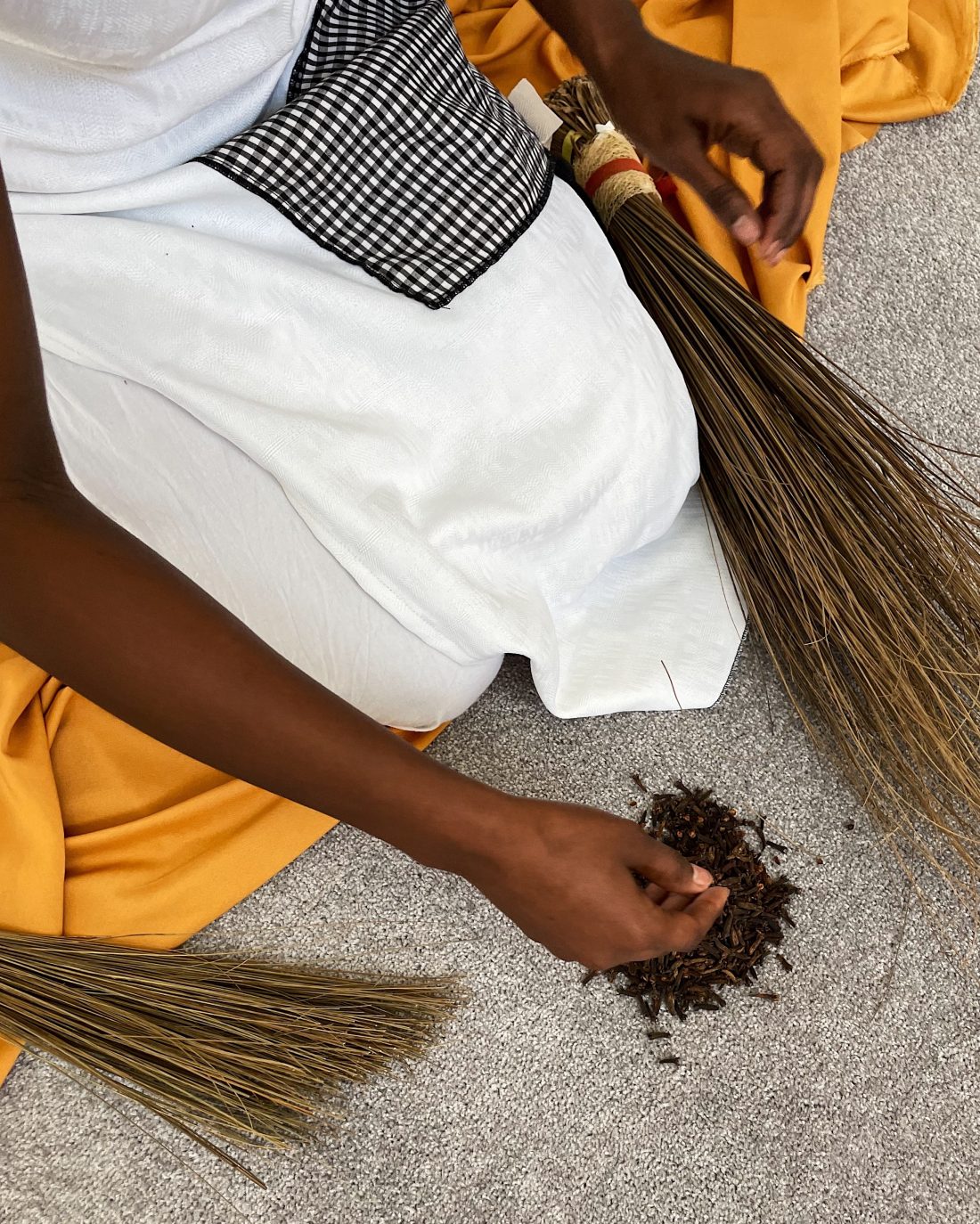
Image courtesy the artist, Valerie Asiimwe Amani and the South London Gallery, 2022.
Ahead of her performance at the South London Gallery on
11 – 12 June 2022, artist Valerie Asiimwe Amani talks us through her processes and inspirations. Her new work, To dismantle a house, is presented in partnership with the Roberts Institute of Art following five weeks in residence at the gallery.
You’ve been in residence at the South London Gallery for a few weeks now. How is that experience for you?
It has been almost three years since my last residency so it felt quite new, but it has been great to be able to have time and the support to put it into one piece. The first week was challenging, in the sense that I had to get myself from visualising the work I proposed to practically thinking how it would materialise. I had also not really spent much time around Camberwell and Peckham so it has been great experiencing a different part of South London.
You work across media including moving image, textile and text. Does all of that play a role in your performance work?
It does – I feel as if I have found a sort of language in those mediums as separate things but what I wanted to explore was how they can communicate with each other to form one thing. Most of my work starts with text, so there was always going to be an aspect of this but it has been interesting thinking of the moving image and textile aspects as supporting elements rather than the focus of the work.
The live performance is one of your first but you’ve previously worked a lot with performance to camera, can you say something about how this changes the work for you?
With performance to camera, there is the comfort of editing – which means that you can control the viewers experience to a certain point. You choose the angle in which they see things and the points in which they hear/read. With live performance there is an aspect of control I have to let go – where I am viewed from, how clearly I am heard (or if that even matters), it all changes. And although I will be doing the performance multiple times, in a way it will be slightly different since it is unedited – my body won’t move around the room in exactly the same way, the audience won’t be stagnant, they can move too, they can choose how they want to experience it. In a way, I guess this is what makes it more intimate.
To dismantle a house focuses on how people interact with domestic spaces both privately and publicly. What was your departure point for this subject matter?
There were a few things, one being an interest in how space in Swahili homes was demarcated, with areas laid out for workers, concubines, wives, husbands etc. I assume many other cultures had this way of separating the house which speaks to the social-political beliefs of where people belong.
When considering public space, borders and identity – the home can be seen as a microcosm forming ideologies that reflect on the performativity of a society – of living, and the things we consider as unseen (or unseeable), intimate and private. My relationship to gender, authority, language, the ‘other’, was first formed or challenged within the domestic space.
You’ve been particularly interested in the Caribbean and African diasporic communities that live in the area around the SLG, how will this interest play a role in your performance on 11 – 12 June?
I think my interest is more so a need for familiarity. I moved to South London (from Oxford) and I was just so relieved to be able to get food (like tilapia, like cassava leaves) that I hadn’t had since moving to the U.K. I guess this informs the performance in how different cultures may intersect in things like food and music. I have never been to the Caribbean (yet) or many West African countries but to some extent, I don’t think of them as foreign places. An aspect of the performance speaks to sharing space – and perhaps why being in this community doesn’t feel foreign.
Could you tell us a little about your artistic inspirations, whether in performance art or more broadly?
I am largely inspired by where I find myself (locality) and also artists who I have worked closely with, which is why I also asked Rehema Chachage and Pamina Sebastião to contribute in a way to this performance since there are so many intersections in our work. I love Otobong Nkangas work and the way in which her practice is vast; I love Portia Zvavahera’s emotive paintings; I also enjoy how Jasleen Kaur incorporates conversation and humour into deeply moving pieces. More broadly speaking I am drawn to stories I was told when I was younger, proverbs, mythology, lyrics and other ways in which we situate culture.
What do you hope people take away from the performance at the South London Gallery?
If i had to choose something idealistic I would hope that it is to ask questions in regards to how to be more mindful of one another. People are being confronted with small violences of being excluded - what does it mean to be here together, what does it look like to actively share space?
This partnership between the Roberts Institute of Art and the South London Gallery was rooted in a collaborative approach in which external, UK-wide nominators put forward a selection of artists who have had limited exposure in London, for consideration by a panel. The panel was composed of representatives from RIA, the South London Gallery as well as Korean-Canadian artist, Zadie Xa.

Image courtesy the artist, Valerie Asiimwe Amani and the South London Gallery, 2022.